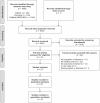The Association Between Monocyte Subsets and Cardiometabolic Disorders/Cardiovascular Disease: A Systematic Review and Meta-Analysis
- PMID: 33681309
- PMCID: PMC7925827
- DOI: 10.3389/fcvm.2021.640124
The Association Between Monocyte Subsets and Cardiometabolic Disorders/Cardiovascular Disease: A Systematic Review and Meta-Analysis
Abstract
Background: Monocyte subsets in humans, i.e., classical (CM), intermediate (IM), and non-classical monocytes (NCM), are thought to differentially contribute to the pathogenesis of atherosclerosis, the leading cause of cardiovascular disease (CVD). However, the association between monocyte subsets and cardiometabolic disorders and CVD is not well-understood. Thus, the aim of the current systematic review and meta-analysis was to evaluate recent findings from clinical studies that examined the association between the distribution of monocyte subsets in subjects with cardiometabolic disorders and CVD compared to healthy controls. Methods: Articles were systematically searched in CINAHL, PubMed and Cochrane Library. Articles were independently screened and selected by two reviewers. Studies that reported the percentage of each monocyte subset were included in the systematic review and meta-analysis. For the meta-analysis, a random-effects model was used to generate pooled standardized mean differences (SMD) between subjects with cardiometabolic disorders and healthy controls. Results: A total of 1,693 articles were screened and 27 studies were selected for qualitative analyses. Among them, six studies were included in the meta-analysis. In total, sample size ranged from 22 to 135 and mean or median age from 22 to 70 years old. We found studies that reported higher percentage and number of IM and/or NCM in subjects with cardiometabolic disorders (9 out of 13 studies) and in subjects with CVD (11 out of 15 studies) compared to healthy controls. In the meta-analysis, the percentage of CM was lower [SMD = -1.21; 95% CI (-1.92, -0.50); P = 0.0009; I 2 = 91%] and the percentage of IM [SMD = 0.56; 95% CI (0.23, 0.88); P = 0.0008; I 2 = 65%] and NCM [SMD = 1.39; 95% CI (0.59, 2.19); P = 0.0007; I 2 = 93%] were higher in subjects with cardiometabolic disorders compared to healthy controls. Conclusions: Individuals with cardiometabolic disorders and CVD may have a higher percentage of IM and NCM than healthy controls. Future studies are needed to evaluate the cause and biological significance of this potential altered distribution of monocyte subsets.
Keywords: cardiometabolic disorder; cardiovascular disease; inflammation; monocytes; systematic review.
Copyright © 2021 Oh, Na and Rogers.
Conflict of interest statement
The authors declare that the research was conducted in the absence of any commercial or financial relationships that could be construed as a potential conflict of interest.
Figures




Similar articles
-
Behavioral and Pharmacotherapy Weight Loss Interventions to Prevent Obesity-Related Morbidity and Mortality in Adults: An Updated Systematic Review for the U.S. Preventive Services Task Force [Internet].Rockville (MD): Agency for Healthcare Research and Quality (US); 2018 Sep. Report No.: 18-05239-EF-1. Rockville (MD): Agency for Healthcare Research and Quality (US); 2018 Sep. Report No.: 18-05239-EF-1. PMID: 30354042 Free Books & Documents. Review.
-
Behavioral Counseling to Promote a Healthful Diet and Physical Activity for Cardiovascular Disease Prevention in Adults Without Known Cardiovascular Disease Risk Factors: Updated Systematic Review for the U.S. Preventive Services Task Force [Internet].Rockville (MD): Agency for Healthcare Research and Quality (US); 2017 Jul. Report No.: 15-05222-EF-1. Rockville (MD): Agency for Healthcare Research and Quality (US); 2017 Jul. Report No.: 15-05222-EF-1. PMID: 29364620 Free Books & Documents. Review.
-
Monocyte Subsets Are Differentially Lost from the Circulation during Acute Inflammation Induced by Human Experimental Endotoxemia.J Innate Immun. 2017;9(5):464-474. doi: 10.1159/000475665. Epub 2017 Jun 23. J Innate Immun. 2017. PMID: 28641299 Free PMC article.
-
Small high-density lipoprotein is associated with monocyte subsets in stable coronary artery disease.Atherosclerosis. 2014 Dec;237(2):589-96. doi: 10.1016/j.atherosclerosis.2014.10.015. Epub 2014 Oct 18. Atherosclerosis. 2014. PMID: 25463093 Free PMC article.
-
Cardiometabolic health in offspring of women with PCOS compared to healthy controls: a systematic review and individual participant data meta-analysis.Hum Reprod Update. 2020 Jan 1;26(1):103-117. doi: 10.1093/humupd/dmz036. Hum Reprod Update. 2020. PMID: 31867675 Free PMC article.
Cited by
-
Inflammatory Cells in Atherosclerosis.Antioxidants (Basel). 2022 Jan 26;11(2):233. doi: 10.3390/antiox11020233. Antioxidants (Basel). 2022. PMID: 35204116 Free PMC article. Review.
-
LDL associates with pro-inflammatory monocyte subset differentiation and increases in chemokine receptor profile expression in African Americans.Int J Cardiol. 2022 Jul 1;358:88-93. doi: 10.1016/j.ijcard.2022.04.038. Epub 2022 Apr 15. Int J Cardiol. 2022. PMID: 35436557 Free PMC article.
-
Monocyte response after colorectal surgery: A prospective cohort study.Front Immunol. 2022 Oct 27;13:1031216. doi: 10.3389/fimmu.2022.1031216. eCollection 2022. Front Immunol. 2022. PMID: 36389839 Free PMC article.
-
Association of Monocyte Count and Monocyte/Lymphocyte Ratio with the Risk of Cardiovascular Outcomes in Patients with CKD.Kidney360. 2022 Feb 3;3(4):657-665. doi: 10.34067/KID.0007922021. eCollection 2022 Apr 28. Kidney360. 2022. PMID: 35721602 Free PMC article.
-
A Novel Monocyte Subset as a Unique Signature of Atherosclerotic Plaque Rupture.Front Cell Dev Biol. 2021 Oct 12;9:753223. doi: 10.3389/fcell.2021.753223. eCollection 2021. Front Cell Dev Biol. 2021. PMID: 34712669 Free PMC article.
References
Publication types
Grants and funding
LinkOut - more resources
Full Text Sources
Other Literature Sources
Medical

